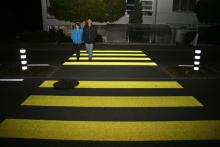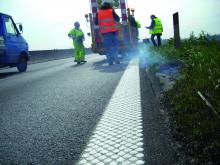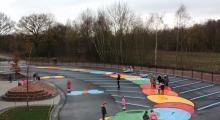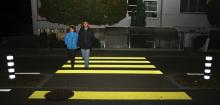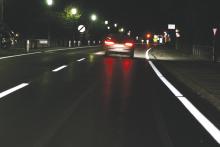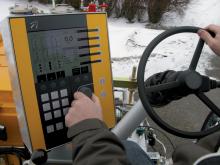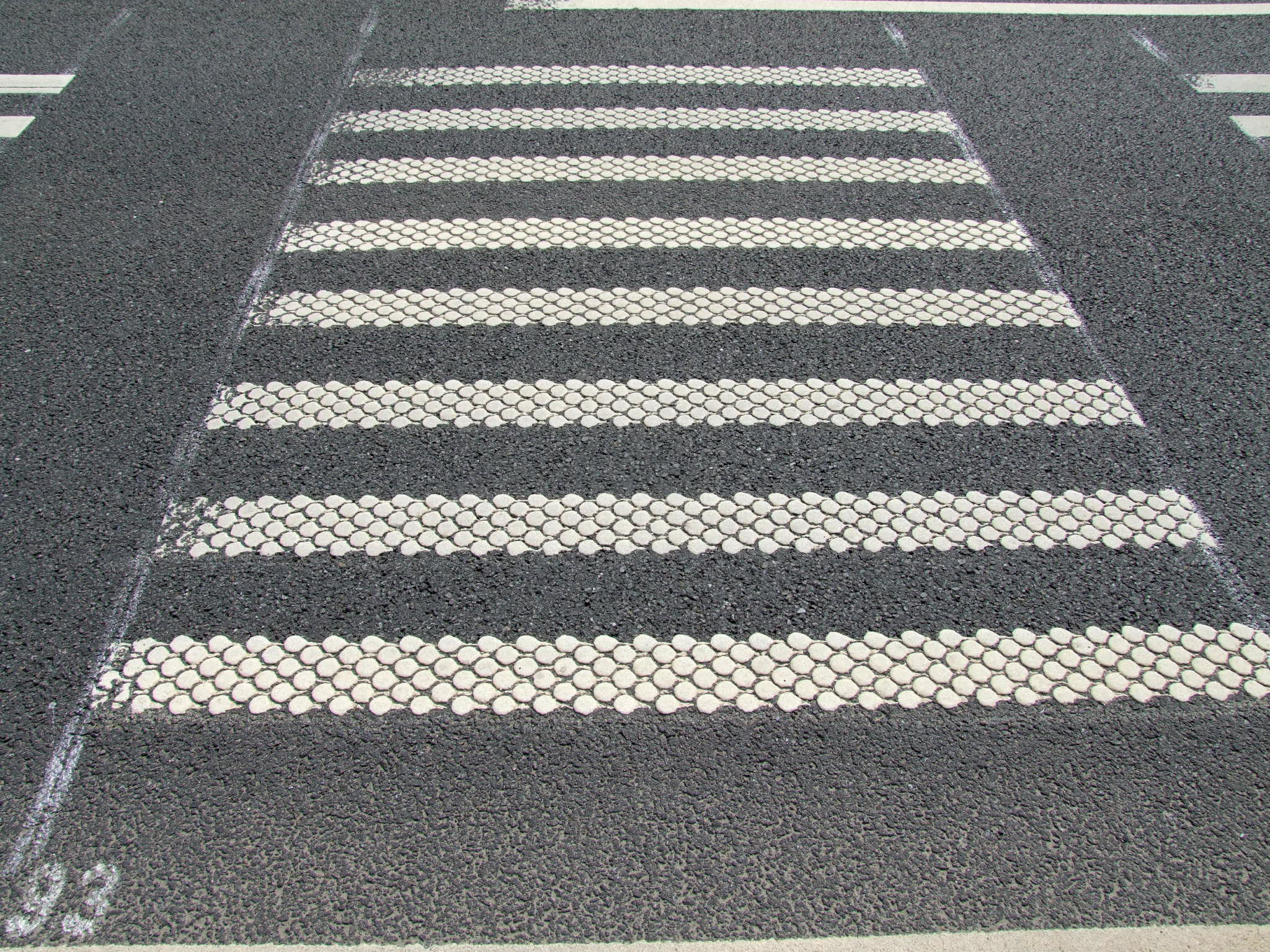
Statistics show that wet weather and the dark is not the best mix for driving, but road markings offer a safety solution
While good road markings are essential any time of the day, it is perhaps at night when roads are wet that they can offer extra guidance. Statistics are said to reveal that an estimated 50% of all accidents happen during the night when it rains but such conditions occur only 10% of the time and when there are usually less vehicles on the road.Indeed, at the 1st Road Marking Symposium held in Amsterdam, The Netherlands, earlier this year alongside
Speaking about rain and road safety he said that rain reduces the visual perception of drivers, pointing out that it also reduces the efficiency of the headlamps and the efficiency of the reflected light.
He said that AETEC's approach is that road markings should be considered by road authorities to compensate drivers for the lack of visibility, and that the properties of retroreflection of a road marking in wet or rainy conditions can be produced by surface texture (as with structured markings); large glass beads or other means.
He said that Type II road markings increase road safety; the benefit/cost ratio of these road markings in terms of road safety is very high; the use of such road markings have to be considered as a "low cost measurement," and their use must be extended in the European Road Network.
Type II road markings as defined in EN 1436 have special properties intended to enhance the retroreflection in wet or rainy conditions while Type I road markings do not necessarily have such special properties.
Indeed, in Europe IS EN 1436 is one of the standards for road markings and is a performance for road-users and an end performance specification concentrating on the needs of the driver.
The standard sets out the various levels of performance that are approved for use in a contract specification, which will govern the required quality of the road marking. It also describes the methods of measuring the various performance characteristics.
The standard gives the performance for the road user of white and yellow road markings based on luminance (colour), day-time visibility, night-time visibility and skid resistance combined with durability. The specification also introduces the importance of wet-night visibility road markings.
IS EN 1436 allows the client to set the performance needs of their road markings.
Road marking characteristics include reflection in daylight or under road lighting (three classes of performance); retroreflection under vehicle headlamp illumination (dry road markings, four classes of performance and in conditions of wetness, four classes of performance), and colour.
Colour takes in luminance (the property of the marking which describes the brightness of its colour) for which there are five classes of performance, while chromaticity is measured when coordinates fall within a defined square on the special chromaticity diagram.
For skid resistance there are six classes of performance.
Meanwhile, Danish company
"The measurements from May 2008 show that ViziSpot meets the requirements from ZTV M 02 [the German road marking standard] and the lines show minor snow plough damages good adhesion and high durability," says LKF.
At the Torfhaus test field, the thermoplastic material ViaTherm B82 from LKF, was used as the material in the ViziSpot Type II marking.
The test field being used is a road trial area for road marking products on the B4 in The Harz close to the city of Torfhaus.
The German Study Union for Road Marking (DSGS) is the organiser of the road trial area, and the markings were applied in August 2006.
The road trial is applied according to the European standard EN 1824 (for road trials), except that wheel passes are not monitored. Each material is applied eight times with a length of 2m. The average daily traffic is 8,000 vehicles.
"Of the 88 road marking systems that were originally placed at the test field Torfhaus in 2006, only ten of these fulfil the technical performance criteria after the second winter. The ViziSpot application is the only thermoplastic Type II road marking system fulfilling the performance criteria," according to LKF.
In road markings tests, readings obtained are measured as millicandelas per lux per square metre (mcd/lux/m²). The Torfhaus site scored 220.5in night visibility (dry) making it a class R4 marking; night visibility (wet), 50.4 (class RW3); and day visibility, 165.6 (class Q4).
LKF explains that its ViziSpot is a road marking system which combines equipment, ViaTherm thermoplastic material and UCme drop-on beads into a line with high functional values. The wet night visibility values are outstanding, but also skid resistance is also high. The ViziSpot system has been developed as a marking system producing a constantly 'broken' line, which offers a rumble effect capable of 'waking' sleepy drivers.
Testing Zebra Bright
Prismo Road Markings, has reported a "remarkable increase in retroreflectivity" during tests on the company's new Zebra Bright road marking system technology, which combines methyl methacrylate reactive paint (MMA) with embedded with the company's white Clusterbeads.
The investigations, using an LTL2000 hand-held retroreflectometer and carried out in September 2008 on an experimental trial area applied a month earlier, are said to have found that the new system increases retroreflectivity five-fold over the norm.
The test areas, comprising two zebra crossings in Nottingham city centre, applied by Prismo Contracting Services, using MMA Cold Plastic (for durability) and white Clusterbeads (for reflectivity), were designed to test for improved dry night-time and wet night-time visibility.
Richard Childs, senior engineer at
This was the first site trial involving MMA modified to take embedded Clusterbeads. The choice of site was perfect for testing the system and Prismo intend to monitor its reflectivity and durability at six-monthly intervals.
"If we can reduce the need for maintaining worn out lines and hence, save money, this can only be a good thing for the authority," said Childs.
Pavement markings
According to
Rain reduces visibility distances and pavement friction (along with vehicle traction and manoeuvrability) and it can create lane obstruction as roadway capacities and traffic speeds decrease while travel time and accident risks rise.
The company says that studies show that wet reflective pavement markings are easily seen in rainy conditions and provide drivers with an increased margin of safety and comfort.
"3M Stamark wet reflective tapes and paint provide superior reflective performance, under wet or dry conditions, compared to traditional pavement markings," claims 3M. The markings feature innovative optics for superior reflectivity, so they are as bright in the rain as they are when dry.
"The reflective lenses in 3M wet reflective pavement markings are encapsulated to ensure a high level of continuous reflective performance, wet or dry. 3M wet reflective products are designed for temporary applications in construction work zones, as well as durable applications."
'Complete portfolio'
In July, Austrian company
SWARCO offers a complete portfolio of road marking materials and is the world's second largest glass bead producer it is also an experienced road marking contractor in Central and Eastern Europe.
"The acquisition of UNIDOC allows us to operate for the first time directly in one of Europe's most important road safety markets," said SWARCO.
"Our operational presence in France will allow us to solidify our position in a road safety market that boasts a road network of approximately 1 million kilometres." Earlier the company had highlighted an "innovative" high performance blend of reflective beads that it says gives a retroreflectivity boost to create enhanced wet night visibility.
"In a series of field tests the wet night performance of road markings integrating plus9spots dRAIN was tested under traffic impact and found to be outstanding. The combinations of SWARCO's top reflectors Megalux beads with plus9spots opens up a new dimension in retroreflection and offer the crucial benefit of safe traffic guidance under wet road conditions.
"Dry retroreflectivity measurements of systems with plus9spots resulted in values of up to 2,000 mcd/m2/lx. Wet retroreflectivity readings with profiled systems using plus9spots dRAIN blends exceed 75 mcd on a longer-term basis." Another development is SWARCO NO. 1 BEADS SOLIDPLUS, among its latest and "most durable" solution for ensuring that road markings remain visible at night.
The company says the beads are an ideal ingredient for increasing the retroreflectivity of structured road marking systems.
Performance levels
ECHOSTAR from
According to Sovitec, using the product guarantees security performance levels under all weather conditions from the moment of the application throughout the entire lifespan of the marking.
The ECHOSTAR glass beads are available in different granulometries in order to meet requested performance levels and match with marking products.
"ECHOSTAR glass beads are made from type A sodo-lime glass and respect the environment since they contain neither hazardous waste nor free silica," says Sovitec, which points out they "have an excellent retroreflection potential" with the refraction index exceeding 1.54.
ECHOSTAR glass beads can be applied using standard equipment.
Road marking characteristics include reflection in daylight or under road lighting (three classes of performance); retroreflection under vehicle headlamp illumination (dry road markings, four classes of performance and in conditions of wetness, four classes of performance), and colour.
Colour takes in luminance (the property of the marking which describes the brightness of its colour) for which there are five classes of performance, while chromaticity is measured when coordinates fall within a defined square on the special chromaticity diagram.
For skid resistance there are six classes of performance.
Meanwhile, Danish company LKF has been carrying out extensive testing of its ViziSpot road marking system, which it says has performed well after a second winter at a test field in Torfhaus, Germany.
"The measurements from May 2008 show that ViziSpot meets the requirements from ZTV M 02 [the German road marking standard] and the lines show minor snow plough damages good adhesion and high durability," says LKF.
At the Torfhaus test field, the thermoplastic material ViaTherm B82 from LKF, was used as the material in the ViziSpot Type II marking.
The test field being used is a road trial area for road marking products on the B4 in The Harz close to the city of Torfhaus.
The German Study Union for Road Marking (DSGS) is the organiser of the road trial area, and the markings were applied in August 2006.
The road trial is applied according to the European standard EN 1824 (for road trials), except that wheel passes are not monitored. Each material is applied eight times with a length of 2m. The average daily traffic is 8,000 vehicles.
"Of the 88 road marking systems that were originally placed at the test field Torfhaus in 2006, only ten of these fulfil the technical performance criteria after the second winter. The ViziSpot application is the only thermoplastic Type II road marking system fulfilling the performance criteria," according to LKF.
In road markings tests, readings obtained are measured as millicandelas per lux per square metre (mcd/lux/m²). The Torfhaus site scored 220.5in night visibility (dry) making it a class R4 marking; night visibility (wet), 50.4 (class RW3); and day visibility, 165.6 (class Q4).
LKF explains that its ViziSpot is a road marking system which combines equipment, ViaTherm thermoplastic material and UCme drop-on beads into a line with high functional values. The wet night visibility values are outstanding, but also skid resistance is also high. The ViziSpot system has been developed as a marking system producing a constantly 'broken' line, which offers a rumble effect capable of 'waking' sleepy drivers.
Testing Zebra Bright
Prismo Road Markings, has reported a "remarkable increase in retroreflectivity" during tests on the company's new Zebra Bright road marking system technology, which combines methyl methacrylate reactive paint (MMA) with embedded with the company's white Clusterbeads.
The investigations, using an LTL2000 hand-held retroreflectometer and carried out in September 2008 on an experimental trial area applied a month earlier, are said to have found that the new system increases retroreflectivity five-fold over the norm.
The test areas, comprising two zebra crossings in Nottingham city centre, applied by Prismo Contracting Services, using MMA Cold Plastic (for durability) and white Clusterbeads (for reflectivity), were designed to test for improved dry night-time and wet night-time visibility.
Richard Childs, senior engineer at Nottingham City Council, said: "The results observed far surpassed our expectations. The readings of 750 millicandelas (mcd) were remarkable. We would have been content seeing results more than the normal 150 mcd." Prismo said the overall findings from the trial were very promising, with the dry results very high and the wet results higher than a standard thermoplastic's dry night time reflectivity.
This was the first site trial involving MMA modified to take embedded Clusterbeads. The choice of site was perfect for testing the system and Prismo intend to monitor its reflectivity and durability at six-monthly intervals.
"If we can reduce the need for maintaining worn out lines and hence, save money, this can only be a good thing for the authority," said Childs.
Pavement markings
According to 3M, traffic accidents are three times more likely in wet, rainy conditions, and in such an environment it does not take long for pavement markings to lose their brightness as surface water negates their reflectivity, making already difficult driving all the more challenging.
Rain reduces visibility distances and pavement friction (along with vehicle traction and manoeuvrability) and it can create lane obstruction as roadway capacities and traffic speeds decrease while travel time and accident risks rise.
The company says that studies show that wet reflective pavement markings are easily seen in rainy conditions and provide drivers with an increased margin of safety and comfort.
"3M Stamark wet reflective tapes and paint provide superior reflective performance, under wet or dry conditions, compared to traditional pavement markings," claims 3M. The markings feature innovative optics for superior reflectivity, so they are as bright in the rain as they are when dry.
"The reflective lenses in 3M wet reflective pavement markings are encapsulated to ensure a high level of continuous reflective performance, wet or dry. 3M wet reflective products are designed for temporary applications in construction work zones, as well as durable applications."
'Complete portfolio'
In July, Austrian company SWARCO Group expanded its operations by taking over UNIDOC SAS, the French road marking contractor based near Paris.
SWARCO offers a complete portfolio of road marking materials and is the world's second largest glass bead producer it is also an experienced road marking contractor in Central and Eastern Europe.
"The acquisition of UNIDOC allows us to operate for the first time directly in one of Europe's most important road safety markets," said SWARCO.
"Our operational presence in France will allow us to solidify our position in a road safety market that boasts a road network of approximately 1 million kilometres." Earlier the company had highlighted an "innovative" high performance blend of reflective beads that it says gives a retroreflectivity boost to create enhanced wet night visibility.
"In a series of field tests the wet night performance of road markings integrating plus9spots dRAIN was tested under traffic impact and found to be outstanding. The combinations of SWARCO's top reflectors Megalux beads with plus9spots opens up a new dimension in retroreflection and offer the crucial benefit of safe traffic guidance under wet road conditions.
"Dry retroreflectivity measurements of systems with plus9spots resulted in values of up to 2,000 mcd/m2/lx. Wet retroreflectivity readings with profiled systems using plus9spots dRAIN blends exceed 75 mcd on a longer-term basis." Another development is SWARCO NO. 1 BEADS SOLIDPLUS, among its latest and "most durable" solution for ensuring that road markings remain visible at night.
The company says the beads are an ideal ingredient for increasing the retroreflectivity of structured road marking systems.
Performance levels
ECHOSTAR from Sovitec are wide granulometric repartition glass beads produced with an original glass composition.
According to Sovitec, using the product guarantees security performance levels under all weather conditions from the moment of the application throughout the entire lifespan of the marking.
The ECHOSTAR glass beads are available in different granulometries in order to meet requested performance levels and match with marking products.
"ECHOSTAR glass beads are made from type A sodo-lime glass and respect the environment since they contain neither hazardous waste nor free silica," says Sovitec, which points out they "have an excellent retroreflection potential" with the refraction index exceeding 1.54.
ECHOSTAR glass beads can be applied using standard equipment.
Training to beat operator bottlenecks
Borum is launching a specialised training course to help the road marking industry meet the need for well-trained staff to ensure better profitability and higher quality.
The Danish manufacturer of road marking machinery says that a shortage of such operators is a constant source of worry for the road marking industry, and it is hoping to relieve these concerns with the tailored courses to train operators.
Borum Road Marking Academy is an additional service from Borum, which already offers on site training with each new machine it sells.
Because road marking is seasonal there is always a need to train additional operators, and that holds whether they have bought a new machine or not," according to Ole Munch, Borum's managing director.
Often in northern countries such as Russia, operators often go out and find other jobs during the winter break and then when spring comes again, the company has to start all over again.
"It's getting more difficult for our customers to find qualified operators, so they have to hire non-qualified operators and give them basic training before they can start to work on a road marking machine," he says.
"Our strategy is that our machinery should have as much uptime as possible. We support that in many ways: by making our machines straightforward to use and easy to service, but also by making them in such a way that an operator understands how to handle them. The Borum Road Marking Academy is an extension of that strategy."
Launching at the start of 2009, the Borum Academy will offer training to new and experienced operators, with teaching built up in modules, so Borum can put together a training course tailor-made to the operator's experience and his employers' needs.

